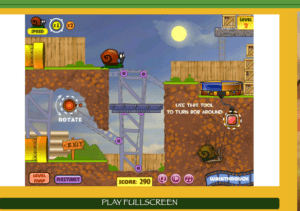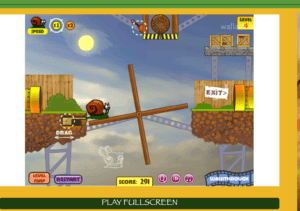For this week’s puzzle critical play, I played an old puzzle game I used to play as a kid on Cool Math games called “Snail Bob” by Hunter Hamster. This game is intended for young elementary school kids, comparable to other children’s puzzle games such as “Fireboy and Watergirl” and “World of Goo” where the puzzles are both aesthetically intriguing to young players as well as simple enough for them to solve. In this game, the main character is a snail named Bob, who travels through different obstacles throughout each level. The narrative of this game is built around the objective of finding snail Bob a new home, as his old home was destroyed by humans. The outcome of each level is to allow Bob to travel to the next level as he searches for his new home. “Snail Bob” touches on multiple types of fun, including sensation, fantasy, narrative, and challenge.
A core mechanic of this game is Bob’s constant state of movement. By default, Bob will always continue to move to the right, and the player must manipulate Bob’s course using the provided mechanisms. This constant state of movement brings in the component of time into the game, as the player now has to learning how to use the mechanisms with respect to time (the order in which to use them, the timing of when to use them, how long to use each of them etc.). This plays into the mechanic of time determining the player’s score for that level. As time moves on, the player’s score decreases. This feeds into the challenging type of fun and creates a sense of urgency for the player. In each level, there is also a design choice of keeping certain mechanisms that the player has previously familiarized themself with and/or the addition of a new mechanism. This variety allows the player to have a need to keep learning patterns. The different combinations of tools and the increasing difficulty of the obstacles serve as puzzles that can maintain engagement for the player.
I believe this game does meet the intended types of fun– sensation, fantasy, narrative, and challenge — especially for me when I was a kid. With each click of a button, there is a sensory noise that is satisfying feedback for the player. Additionally, the premise of the game is very busy and inconsistent, which can retain the attention of a young player. All layered on top of the playful soundtrack, this game targets desirable childhood sensations. The game’s use of fantasy and narrative also builds a lighthearted story into the game of challenging obstacles. As a designer, I would recommend that this game possibly reevaluate the inconsistency of the game. Even though there is value to the business, lots of inconsistency in many contexts (buttons, music, animations, colors, etc) can cause confusion or neglect of certain mechanics, especially considering the young audience.




